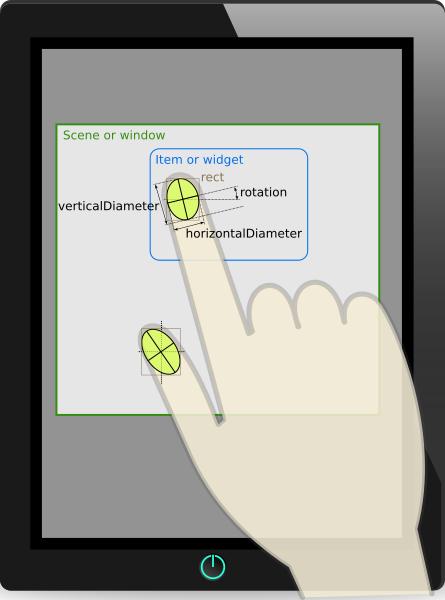TouchPoint¶
- PyQt5.QtGui.QTouchEvent.TouchPoint
Enums¶
- InfoFlag
TODO
Member
Value
Description
Pen TODO
TODO
Token TODO
TODO
Methods¶
- ellipseDiameters() → QSizeF
TODO
- flags() → InfoFlags
TODO
- id() → int
Returns the id number of this touch point.
Do not assume that id numbers start at zero or that they are sequential. Such an assumption is often false due to the way the underlying drivers work.
- lastNormalizedPos() → QPointF
Returns the normalized position of this touch point from the previous touch event.
The coordinates are normalized to the size of the touch device, i.e. (0,0) is the top-left corner and (1,1) is the bottom-right corner.
See also
- lastPos() → QPointF
Returns the position of this touch point from the previous touch event, relative to the widget or QGraphicsItem that received the event.
See also
- lastScenePos() → QPointF
Returns the scene position of this touch point from the previous touch event.
The scene position is the position in QGraphicsScene coordinates if the QTouchEvent is handled by a QGraphicsItem::touchEvent() reimplementation, and identical to the screen position for widgets.
See also
- lastScreenPos() → QPointF
Returns the screen position of this touch point from the previous touch event.
See also
- normalizedPos() → QPointF
Returns the normalized position of this touch point.
The coordinates are normalized to the size of the touch device, i.e. (0,0) is the top-left corner and (1,1) is the bottom-right corner.
See also
- pos() → QPointF
Returns the position of this touch point, relative to the widget or QGraphicsItem that received the event.
See also
startPos(), lastPos(), screenPos(), scenePos(), normalizedPos().
- pressure() → float
Returns the pressure of this touch point. The return value is in the range 0.0 to 1.0.
- rawScreenPositions() → List[QPointF]
TODO
- rect() → QRectF
Returns the rect for this touch point, relative to the widget or QGraphicsItem that received the event. The rect is centered around the point returned by pos().
Note: This function returns an empty rect if the device does not report touch point sizes.
of the touchpoint regardless of rotation, whereas a touchpoint is more correctly modeled as an ellipse at position pos() with ellipseDiameters() which are independent of rotation().
See also
- rotation() → float
TODO
- scenePos() → QPointF
Returns the scene position of this touch point.
The scene position is the position in QGraphicsScene coordinates if the QTouchEvent is handled by a QGraphicsItem::touchEvent() reimplementation, and identical to the screen position for widgets.
See also
- sceneRect() → QRectF
Returns the rect for this touch point in scene coordinates.
Note: This function returns an empty rect if the device does not report touch point sizes.
of the touchpoint regardless of rotation, whereas a touchpoint is more correctly modeled as an ellipse at position scenePos() with ellipseDiameters() which are independent of rotation().
See also
- screenPos() → QPointF
Returns the screen position of this touch point.
See also
- screenRect() → QRectF
Returns the rect for this touch point in screen coordinates.
Note: This function returns an empty rect if the device does not report touch point sizes.
touchpoint regardless of rotation, whereas a touchpoint is more correctly modeled as an ellipse at position screenPos() with ellipseDiameters() which are independent of rotation().
See also
- startNormalizedPos() → QPointF
Returns the normalized starting position of this touch point.
The coordinates are normalized to the size of the touch device, i.e. (0,0) is the top-left corner and (1,1) is the bottom-right corner.
See also
- startPos() → QPointF
Returns the starting position of this touch point, relative to the widget or QGraphicsItem that received the event.
- startScenePos() → QPointF
Returns the starting scene position of this touch point.
The scene position is the position in QGraphicsScene coordinates if the QTouchEvent is handled by a QGraphicsItem::touchEvent() reimplementation, and identical to the screen position for widgets.
See also
- startScreenPos() → QPointF
Returns the starting screen position of this touch point.
See also
- state() → TouchPointState
Returns the current state of this touch point.
- uniqueId() → QPointingDeviceUniqueId
TODO
- velocity() → QVector2D
TODO

